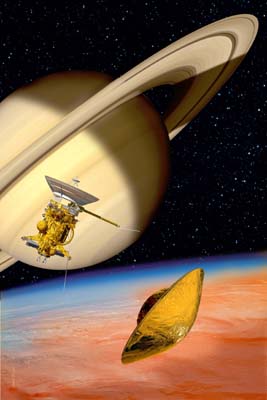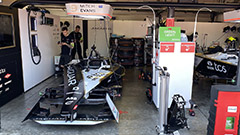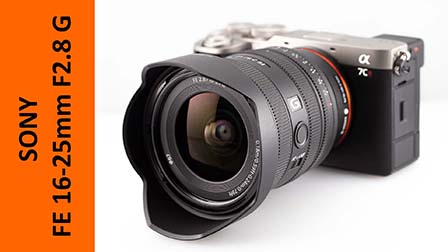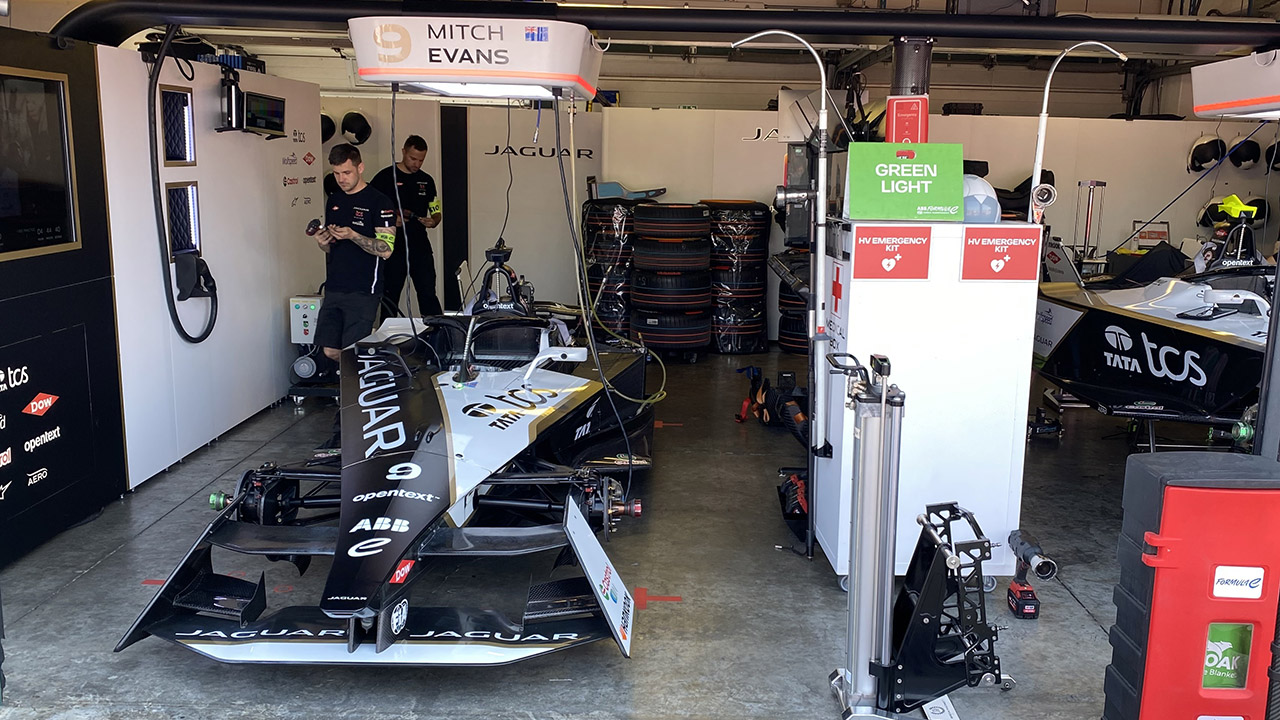|
|||||||
|
|
|
 |
|
|
Strumenti |
|
|
#1 |
|
Senior Member
Iscritto dal: Nov 2001
Città: Padova
Messaggi: 1635
|
[Space] NASA-ESA - Cassini-Hyugens
Cassini-Hyugens è la prima missione scientifica interplanetaria congiunta tra più agenzie spaziali: NASA ed ESA, e l'italiana ASI.
Si tratta di una navetta interstellare, la più grande mai costruita, composta da un'orbiter (Cassini, NASA) e da una sonda (Hyugens, ESA). Per la prima volta nella storia una sonda atterrerà su un asteroide del sistema solare esterno.  Dal sito NASA della missione, http://saturn.jpl.nasa.gov/index.cfm: With its stunning rings and dozen of moons, Saturn is an intriguing planet for many reasons. Barely smaller than Jupiter, it formed four billion years ago and it is made mainly of gas. It is also the only known planet that is less dense than water, meaning that if it could be placed inside an imaginary gigantic bathtub it would float. Saturn has a huge magnetosphere and a stormy atmosphere, with winds clocked at 1,800 kilometers (1,118 miles) per hour near its equator. Of the 31 known moons orbiting Saturn, Titan is the largest. Bigger than the planet Mercury and our own moon, Titan is of particular interest to scientists because it is the only moon in the solar system with its own atmosphere. But what sets Saturn apart from the rest of the planets in the solar system are its picturesque rings. Made up by billions of ice and rock particles of all sizes -- from small debris to boulders as big as houses -- these rings orbit Saturn at varying speeds. There are hundreds of these rings, believed to be pieces of shattered comets, asteroids or moons that broke apart before they reached the planet. The rings are so big that they would fill most of the distance between Earth and the Moon. For centuries, Saturn and its rings puzzled observers, in particular, Italian astronomer Galileo Galilei. The first to use a telescope to explore the wonders of the heavens, Galileo couldn't understand why Saturn looked different in the night sky at varying times-- a phenomenon that we now know is caused by the shifting of our view of the ring plane. Because of this, when the rings face Earth edge-on they are virtually invisible. They seem to reappear months later when our angle of view changes. Despite major advances in lens technology since Galileo's time, many questions still need to be answered through exploration of Saturn's rings. Launched from Kennedy Space Center on Oct. 15, 1997, the Cassini-Huygens spacecraft will reach the Saturnian region in July 2004. The mission is composed of two elements: The Cassini orbiter that will orbit Saturn and its moons for four years, and the Huygens probe that will dive into the murky atmosphere of Titan and land on its surface. The sophisticated instruments onboard these spacecraft will provide scientists with vital data to help understand this mysterious, vast region. Cassini-Huygens is an international collaboration between three space agencies. Seventeen nations contributed to building the spacecraft. The Cassini orbiter was built and managed by NASA's Jet Propulsion Laboratory. The Huygens probe was built by the European Space Agency. The Italian Space agency provided Cassini's high-gain communication antenna. More than 200 scientists worldwide will study the data collected. Dal sito ESA della missione, http://www.esa.int/export/esaSC/120378_index_0_m.html: Mission Huygens will be the first probe to land on a world in the outer Solar System - on the surface of Titan, Saturn’s largest moon. The Huygens data may offer clues about how life began on Earth. Huygens is currently in space, hitching a ride on NASA’s Cassini spacecraft. While the Cassini orbiter continues to explore Saturn and its rings, the Huygens probe will be released to parachute through the atmosphere of Titan. Shrouded in an orange haze that hides its surface, Titan is one of the most mysterious objects in our solar system. It is the second largest moon (only Jupiter's Ganymede is bigger), and the only one with a thick atmosphere. It is this atmosphere that excites scientific interest, since it is thought to resemble that of a very young Earth. Huygens's six instruments will take measurements throughout its descent, providing details on the chemical composition of Titan's atmosphere, its weather and clouds, and then the surface itself. Spectacular data and images are already expected from the descent and, if the Huygens probe survives the impact with the mysterious surface, it will continue to send unique information back to the Cassini orbiter until its batteries expire or it is out of range. What's special? Huygens's goals are to study the atmosphere and the surface of Titan along the descent ground track and near the landing site. The Huygens instruments will make detailed on-the-spot measurements of Titan's atmospheric, looking at its structure, composition and dynamics. Images and other remote-sensing measurements of the surface of Titan will also be made during the descent. After a descent of about 137 minutes, the probe will impact the surface at about 5-6 metres per second. It is hoped that the probe will survive this impact for at least a few minutes and that the instruments are also able to make direct measurements of the state and composition of the landing site surface. Preserved in the deep freeze of Titan's atmosphere are chemical, carbon-rich compounds thought to be similar to those of Earth's primeval soup. The in-situ results from Huygens, combined with Cassini's global observations from repeated flybys of Titan, will provide vital information towards the great mystery of how life began on Earth. Spacecraft The first element of the Huygens system consists of the 318-kilogram Huygens probe itself, which enters Titan's atmosphere after separating from the Cassini orbiter. It consists of two parts: the Entry Assembly (ENA) which cocoons the Descent Module (DM). The ENA connects the Huygens probe to the Cassini orbiter until it initiates and performs the ejection of the probe. It then controls the cruise to Titan, provides thermal protection during entry and the parachutes decelerate the probe in time for the landing on Titan. It is then jettisoned, releasing the DM. The DM comprises an aluminium shell and inner structure containing all the experiments and probe support subsystems, including the parachute descent and spin control devices. The second element of the Huygens system is the 30-kilogram Probe Support Equipment (PSE), which remains attached to the orbiter after probe separation. The PSE consists of four electronic boxes aboard the orbiter providing control and communications. It provides power and data links between the probe and orbiter before the probe is launched. Journey The large Cassini/Huygens spacecraft used four gravity-assist swing-by manoeuvres: Venus (April 1998), Venus (June 1999), Earth (August 1999) and Jupiter (December 2000) on its journey towards Saturn and Titan. In early 2005, towards the end of Cassini's third orbit around Saturn, the Huygens probe is ejected on a 22-day cruise to Titan. History The development of the Cassini/Huygens mission, a complex and ambitious venture between NASA and ESA, required substantial scientific, technical and programme planning efforts over several years. In the late 1970s, NASA studied several scenarios for a mission to Saturn as the next natural step after the Galileo orbiter/probe mission to Jupiter in the detailed exploration of the giant planets. The Cassini mission was originally proposed in November 1982 by a team of European and American scientists as a collaborative initiative with NASA in response to a regular call for mission ideas by ESA. Very early in the study phase, the Titan probe was identified as ESA’s potential contribution to the international Cassini mission. It was within the technical capabilities of the European space industry, which had limited experience in planetary missions, mainly acquired with the Giotto mission. During the evaluation studies, the need for using planetary gravity-assist manoeuvres was identified in order to send the spacecraft towards Saturn, as no launcher existed that was powerful enough to send it directly to Saturn. Three launch opportunities were identified; each included a Jupiter fly-by in addition to Venus and Earth fly-bys. A fly-by of Jupiter is required to reach Saturn in a reasonable time: 6.7 years, instead of 9–10 years. The Titan probe was named Huygens in honour of the Dutch astronomer who discovered Titan in 1655. Partnerships There are six instruments on board the Huygens probe, each developed by different teams. The Huygens Atmosphere Structure Instrument comprises sensors for measuring the physical and electrical properties of the atmosphere and an on-board microphone that will send back sounds from Titan. This is led by the Université de Paris VII, Observatoire de Paris-Meudon, France, with contributions from Italy, Austria, Germany, Spain, France, the United Kingdom, Norway, Finland, and the United States. The Gas Chromatograph and Mass Spectrometer is a versatile gas chemical analyser designed to identify and quantify various atmospheric constituents. It is also equipped with gas samplers which will be filled at high altitude for analysis later in the descent when more time is available. This is led by NASA and supported by contributions from the Austria and France. The Aerosol Collector and Pyrolyser will collect aerosols for chemical-composition analysis. After extension of the sampling device, a pump will draw the atmosphere through filters which capture aerosols. Each sampling device can collect about 30 micrograms of material. This is managed by the French CNRS Service d'Aéronomie, with support from Austria and the United States. The Descent Imager/Spectral Radiometer can take images and make spectral measurements using sensors covering a wide spectral range. A few hundred metres before impact, the instrument will switch on its lamp in order to acquire spectra of the surface material. This is provided by the University of Arizona, United States, with support from Germany and France. The Doppler Wind Experiment uses radio signals to deduce atmospheric properties. The probe drift caused by winds in Titan's atmosphere will induce a measurable Doppler shift in the carrier signal. The swinging motion of the probe beneath its parachute and other radio-signal-perturbing effects, such as atmospheric attenuation, may also be detectable from the signal. This is managed by the Universität Bonn, Germany, with collaboration from Italy and the United States. The Surface-Science Package is a suite of sensors to determine the physical properties of the surface at the impact site and to provide unique information about its composition. The package includes an accelerometer to measure the impact deceleration, and other sensors to measure the index of refraction, temperature, thermal conductivity, heat capacity, speed of sound, and dielectric constant of the (liquid) material at the impact site. The Open University, United Kingdom, manages this with support from ESA, Italy and the United States. Huygens factsheet Landing on Titan, Saturn's mysterious moon Name: Christiaan Huygens (1629-1695) was a Dutch astronomer who discovered Saturn's rings and, in 1655, its largest moon, Titan. Description: Huygens will be the first probe to land on a world in the outer Solar System - on the surface of Titan, Saturn’s largest moon. Data from Huygens may offer clues about how life began on Earth. Huygens is currently in space, hitching a ride on NASA’s Cassini spacecraft. Launch 15 October 1997 (Titan-IVB/Centaur at Cape Canaveral, United States). Status In operation - due to arrive at Titan in early 2005. Journey The 5.6-tonne Cassini/Huygens spacecraft did four gravity-assist swing-by manoeuvres. These manoeuvres were: Venus (April 1998), Venus (June 1999), Earth (August 1999), and Jupiter (December 2000). In December 2004, towards the end of Cassini's third orbit around Saturn, the Huygens probe will be ejected on a 22-day cruise to Titan. Huygens is due to reach Titan on 14 January 2005. Notes Cassini/Huygens is the largest interplanetary spacecraft ever built. Gravity-assists from two swing-bys of Venus and one of Earth provide the equivalent of 68 040 kilograms of rocket fuel. It is dormant during the long journey to Saturn, so ESA scientists 'wake up' Huygens every six months to check that all is well. The Huygens probe can withstand temperatures of up to 18 000°C in front of the heat shield. The heat generated as Huygens travels through Titan's thick gas atmosphere will be immense. Titan is one of the most mysterious objects in our Solar System. It is the second largest moon and the only one with a thick, methane-rich, nitrogen atmosphere. Experts think that its atmosphere resembles that of a very young Earth. La navetta Cassini con la sonda Hyugens: 
__________________
Cosmos Pure | Core i7 860 | P7P55D-E Deluxe | 16GB DDR3 Vengeance | HD5850 | 2x850PRO 256GB | 2xRE3 250GB | 2xSpinPoint F3 1TB Ultima modifica di GioFX : 18-01-2004 alle 12:15. |
|
|

|
|
|
#2 |
|
Bannato
Iscritto dal: Feb 2002
Città: Sanremo, Italy
Messaggi: 1905
|
|
|
|

|
|
|
#3 |
|
Senior Member
Iscritto dal: Nov 2001
Città: Padova
Messaggi: 1635
|
Getting closer to the Lord of the Rings
16 January 2004 This time next year, ESA’s Huygens spaceprobe will be descending through the atmosphere of Saturn’s largest moon, becoming the first spacecraft to land on a body in the outer Solar System. Earlier this month, the giant ringed planet Saturn was closer to Earth than it will be for the next thirty years. All the planets orbit the Sun as if on a giant racetrack, travelling in the same direction but in different lanes. Those in the outer lanes have further to travel than those on the inside lanes. So, Earth regularly ‘laps’ the further planets. On New Year’s Eve 2003, Earth overtook Saturn, drawing closer than at any time in the next three decades. Through a small telescope, Saturn is normally visible as a creamy yellow ‘star’. You may be able to see the ring system that the planet is famous for, and its largest moon Titan will show up as a tiny dot of light. That tiny dot is the destination for ESA’s Huygens probe and may hold vital clues about how life began on Earth. Titan is the only moon with a thick atmosphere in the Solar System. Astronomers think this atmosphere might closely match the one Earth possessed millions of years ago, before life began. Certainly Titan’s atmosphere is rich in carbon, the chemical necessary for life on Earth. What is more, this is all stored in ‘deep freeze’, ten times further from the Sun than the Earth. The big mystery is Titan’s surface, which is hidden by a cloud layer. This is why ESA built Huygens, to probe through this layer which is impenetrable by Earth-based observations. In January 2005, Huygens will parachute below the clouds to see what is really going on. Its battery of instruments will return over 1000 images as it floats down and samples the chemistry of this exotic place. The Titan probe was named Huygens in honour of the Dutch astronomer who discovered Titan in 1655. Launched in October 1997, Huygens is currently in space, hitching a ride on NASA’s Cassini spacecraft. So look forward to seeing more of Saturn and a tiny European spacecraft called Huygens, that in one year’s time will make an historic landing in the quest to uncover the origins of life.
__________________
Cosmos Pure | Core i7 860 | P7P55D-E Deluxe | 16GB DDR3 Vengeance | HD5850 | 2x850PRO 256GB | 2xRE3 250GB | 2xSpinPoint F3 1TB |
|
|

|
|
|
#4 |
|
Senior Member
Iscritto dal: Nov 2001
Città: Padova
Messaggi: 1635
|
Note:
La dimensione e l'obiettivo di Cassini-Huygens (Saturno-Titano) ha richiesto l'uso del più potente lanciatore espandibile al mondo, il Titan IV/Centaur, ma questo non basta a lanciare direttamente la navetta verso la sua destinazione, è stata quindi studiata una traiettoria unica nel suo genere che ha previsto lo sfruttamento della forza gravitazionale di Venere (2 passaggi, 1998-99) e della Terra (2001). Cassini usa come le precedenti sonde interplanetarie e navette Apollo, Viking, Pioneer e Voyager o le attuali Galileo e Ulysses, un generatore termoelettrico a radioisotopi (RTG) per produrre energia elettrica necessaria a missioni lunghe parecchi anni. Un RTG non è un reattore nucleare, e non sfrutta nè processi di fissione nè di fusione nucleare, bensì genera calore con la naturale decadenza radioattiva dell'isotopo plutonio-238 (non adatto ad uso militare). Il calore così prodotto è convertito in elettricità da convertitori termoelettrici a stato solido. 
__________________
Cosmos Pure | Core i7 860 | P7P55D-E Deluxe | 16GB DDR3 Vengeance | HD5850 | 2x850PRO 256GB | 2xRE3 250GB | 2xSpinPoint F3 1TB Ultima modifica di GioFX : 18-01-2004 alle 15:19. |
|
|

|
|
|
#5 | |
|
Senior Member
Iscritto dal: Feb 2000
Città: Roma (S.E.) Trattative_concluse: 300+
Messaggi: 15647
|
Quote:
troppo fico
__________________
I ricordi sono sempre tristi: quelli brutti perchè sono amari, quelli belli perché sono solo ricordi
Dal mio corpo in putrefazione cresceranno dei fiori, e io sarò dentro di loro. Questa è l'eternità. (E. Munch) |
|
|
|

|
|
|
#6 | |
|
Senior Member
Iscritto dal: Mar 2001
Messaggi: 1857
|
Quote:
|
|
|
|

|
|
|
#7 |
|
Senior Member
Iscritto dal: May 2001
Messaggi: 631
|
nel 96-97 avevo molto seguito la cotruzione della sonda tutto il progetto generale...non vedo l'ora che arrivi
__________________
Però, va forte quest'auto! |
|
|

|
|
|
#8 |
|
Registered User
Iscritto dal: Jul 2003
Messaggi: 2493
|
ok, potrei dire una cavolata, ma un generatore a radioisotopi visto la sua longevita', non potrebbe essere adattato per alimentare pc portatili, cellulari e altri apparecchi domestici?
costerebbe troppo? troppo pericoloso? |
|
|

|
|
|
#9 | |
|
Senior Member
Iscritto dal: Mar 2001
Messaggi: 1857
|
Quote:
Senza considerare che io un cellulare con una batteria all'uranio per quanto sicuro non me lo metterei all'orecchio... Per quel tipo di prodotti il futuro saranno le batterie a celle combustibili. I portatili avranno un'autonomia di qualche giorno i cellulari forse anche un paio di settimane... oltretutto meno problemi di smaltimento. |
|
|
|

|
|
|
#10 |
|
Registered User
Iscritto dal: Jul 2003
Messaggi: 2493
|
in effetti era un paragone azzardato, ma sarebbe fantastico poter usufruire di batterie con quella durata
tocchera' aspettare le batterie celle combustubili... |
|
|

|
|
|
#11 | |
|
Senior Member
Iscritto dal: Nov 2001
Città: Padova
Messaggi: 1635
|
Quote:
__________________
Cosmos Pure | Core i7 860 | P7P55D-E Deluxe | 16GB DDR3 Vengeance | HD5850 | 2x850PRO 256GB | 2xRE3 250GB | 2xSpinPoint F3 1TB |
|
|
|

|
|
|
#12 | |
|
Senior Member
Iscritto dal: Feb 2000
Città: Roma (S.E.) Trattative_concluse: 300+
Messaggi: 15647
|
Quote:
eh eh... magari. pensa allora alle macchine elettriche...
__________________
I ricordi sono sempre tristi: quelli brutti perchè sono amari, quelli belli perché sono solo ricordi
Dal mio corpo in putrefazione cresceranno dei fiori, e io sarò dentro di loro. Questa è l'eternità. (E. Munch) |
|
|
|

|
|
|
#13 | |
|
Senior Member
Iscritto dal: Feb 2000
Città: Roma (S.E.) Trattative_concluse: 300+
Messaggi: 15647
|
Quote:
e adeguare gli strumenti a quelle... ovviamente se non ci fossero i rpoblemi costi-pericolosita'
__________________
I ricordi sono sempre tristi: quelli brutti perchè sono amari, quelli belli perché sono solo ricordi
Dal mio corpo in putrefazione cresceranno dei fiori, e io sarò dentro di loro. Questa è l'eternità. (E. Munch) |
|
|
|

|
|
|
#14 |
|
Senior Member
Iscritto dal: Nov 2001
Città: Padova
Messaggi: 1635
|
On Final Approach, Cassini Photographs Saturn
By Robert Roy Britt Senior Science Writer posted: 09:46 am ET 27 February 2004 The Cassini spacecraft has returned a detailed new picture of Saturn as the craft makes its final approach toward the ringed planet. The image is the first of many that should now begin to flow from the mission. "Prepare to be amazed," said Carolyn Porco, Cassini imaging team leader at the Space Science Institute in Boulder, CO. In the new photograph, Saturn is 60 percent larger than it was in the last Cassini image, made in December. Details are visible in the planet's rings and clouds. And already scientists have found a puzzle. There is a "noticeable absence" of ghostly, spoke-like dark markings in the rings. The features were discovered during the approach of the Voyager probe 23 years ago. Porco said this new puzzle is one of many in store for the mission. The origin of the rings is itself a mystery. Porco said images will now be released weekly, then more frequently starting in late May. The spacecraft will enter orbit around Saturn on July 1. The mission will explore the planet's atmosphere and its rings and moons. Scientists expect to find previously unknown moons embedded in the rings, which contain icy particles from dust-grain size up to rocks and boulders. On May 18, Cassini will enter the Saturn system, passing a group of outer moons as the gravitational pull of the giant planet begins to overpower that of the Sun. Observations of Saturn's largest moon, Titan, will begin a few days later. On June 11, Cassini will photograph the moon Phoebe during a flyby. Phoebe is 137 miles (220 kilometers) wide, the largest of Saturn's outer moons and probably a captured asteroid. Cassini launched in 1997. To save fuel and money, it made several planetary flybys to get speed boosts by stealing a little orbital energy from the planets. It looped around Venus twice, then flew past Earth. Later it studied and photographed Jupiter while getting a final push toward Saturn. The spacecraft will release its piggybacked Huygens probe about six months after arriving at Saturn. Huygens will descend through the thick atmosphere of Titan on Jan. 14, 2005. The new image was taken Feb. 9 and released today. Cassini was 43.1 million miles (69.4 million kilometers) from Saturn. The image contrast and colors have been slightly enhanced to improve visibility. The icy moon Enceladus is faintly visible to the left, outside the rings. Enceladus is about 323 miles (520 kilometers) wide. Its brightness has been increased seven times relative to the planet, in order to make it noticeable. Cassini will investigate the moon more closely later in the mission. Cassini has traveled 2.1 billion miles (3.4 billion kilometers) on its looping path. The mission is a cooperative effort of NASA, the European Space Agency and the Italian Space Agency.  This picture of Saturn was taken by Cassini on Feb. 9 and released Feb. 27. Notably absent are spokes in the rings seen by the Voyager spacecraft.
__________________
Cosmos Pure | Core i7 860 | P7P55D-E Deluxe | 16GB DDR3 Vengeance | HD5850 | 2x850PRO 256GB | 2xRE3 250GB | 2xSpinPoint F3 1TB |
|
|

|
|
|
#15 | |
|
Senior Member
Iscritto dal: Mar 2001
Messaggi: 1857
|
immagini di saturno in movimento...
Quote:

|
|
|
|

|
|
|
#16 |
|
Senior Member
Iscritto dal: Nov 2001
Città: Padova
Messaggi: 1635
|
Ocean waves forecast for Saturn's moon Titan
ROYAL ASTRONOMICAL SOCIETY NEWS RELEASE Posted: March 31, 2004  When the European Huygens probe on the Cassini space mission parachutes down through the opaque smoggy atmosphere of Saturn's moon Titan early next year, it may find itself splashing into a sea of liquid hydrocarbons. In what is probably the first piece of "extraterrestrial oceanography" ever carried out, Dr Nadeem Ghafoor of Surrey Satellite Technology and Professor John Zarnecki of the Open University, with Drs Meric Srokecz and Peter Challenor of the Southampton Oceanography Centre, calculated how any seas on Titan would compare with Earth's oceans. Their results predict that waves driven by the wind would be up to 7 times higher but would move more slowly and be much farther apart. Dr Ghafoor will present their findings at the RAS National Astronomy Meeting at the Open University on Wednesday. The team worked with a computer simulation, or 'model', that predicts how wind-driven waves on the surface of the sea are generated on Earth, but they changed all the basic inputs, such as the local gravity, and the properties of the liquid, to values they might expect on Titan. Arguments about the nature of Titan's surface have raged for a number of years. Following the flyby of the Voyager 1 spacecraft in 1980, some researchers suggested that Titan's concealed surface might be at least partly covered by a sea of liquid methane and ethane. But there are several other theories, ranging from a hard icy surface at one extreme to a near-global hydrocarbon ocean at the other. Other variants include the notion of hydrocarbon 'sludge' overlying an icy surface. Planetary scientists hope that the Cassini/Huygens mission will provide an answer to this question, with observations from Cassini during several flybys of Titan and from Huygens, which will land (or 'splash') on 14 January 2005. The idea that Titan has significant bodies of surface liquid has recently been reinforced by the announcement that radar reflections from Titan have been detected using the giant Arecibo radio dish in Puerto Rico. Importantly, the returned signals in 12 out the 16 attempts made contained reflections of the kind expected from a polished surface, like a mirror. (This is similar to seeing a blinding patch of light on the surface of the sea where the Sun is being reflected.) The radar researchers concluded that 75% of Titan's surface may be covered by 'open bodies of liquid hydrocarbons' -- in other words, seas. The exact nature of the reflected radar signal can be used to determine how smooth or choppy the liquid surface is. This interpretation says that the slope of the waves is typically less than 4 degrees, which is consistent with the predictions of the British scientists, who showed that the maximum possible slope of waves generated by wind speeds up to 7 mph would be 11 degrees. "Hopefully ESA's Huygens probe will end the speculation" says Dr Ghafoor. "Not only will this be by far the most remote soft landing of a spacecraft ever attempted but Huygens might become the first extraterrestrial boat if it does indeed land on a hydrocarbon lake or sea." Although not designed specifically to survive landing or to float, the chances it will do so are reasonable. However, the link back to Earth from Huygens via Cassini, which will be flying past Titan and acting as a relay, will only last for a maximum of 2 hours. During this time, if the probe is floating on a sea, one of the 6 instruments Huygens is carrying, the Surface Science Package experiment, which is led by John Zarnecki, will be making oceanography measurements. Among the 9 sensors that it carries are ones that will measure the height and frequency of the waves and also the depth of the sea using sonar. It will also attempt to determine the composition of the sea. What would the sea look like? "Huygens does carry a camera so it is possible we shall have some direct images," says Professor Zarnecki, "but let's try to imagine that we are sitting onboard the probe after it has landed in a Titan ocean. What would we see? Well, the waves would be more widely dispersed than on Earth but they will be very much higher - mostly as a result of the fact that Titan gravity is only about 15% of that on Earth. So the surface around us would probably appear flat and deceptively calm, but in the distance we might see a rather tall, slow-moving wave advancing towards us -- a wave that could overwhelm or sink us."
__________________
Cosmos Pure | Core i7 860 | P7P55D-E Deluxe | 16GB DDR3 Vengeance | HD5850 | 2x850PRO 256GB | 2xRE3 250GB | 2xSpinPoint F3 1TB |
|
|

|
|
|
#17 |
|
Senior Member
Iscritto dal: Mar 2001
Messaggi: 1857
|
questa missione se ha successo potrebbe quasi oscurare quella su Marte... chissà che paesaggio ci troveremo davanti su Titano? L'aspetto di marte in fin dei conti ci era noto... di Titano abbiamo solo le foto del voyager...
|
|
|

|
|
|
#18 |
|
Senior Member
Iscritto dal: Sep 2000
Città: lodi-crema-milano.
Messaggi: 12280
|
perdonatemi se vado offtopic, ma non volevo aprire una nuova discussione........
qualcuno qua saprebbe dirmi la velocità a cui atterra uno shuttle? è una curiosità che mi devo levare grazie
__________________
La teoria è quando si sa tutto e niente funziona. La pratica è quando tutto funziona e nessuno sa il perché. Noi abbiamo messo insieme la teoria e la pratica: non c'è niente che funzioni... e nessuno sa il perché! |
|
|

|
|
|
#19 | |
|
Senior Member
Iscritto dal: Nov 2001
Città: Padova
Messaggi: 1635
|
Quote:
Lo Shuttle viagga così: - 26,500 km/h poco prima dell'ingresso in atmosfera (T-60min al touch down, 282 km di altezza) - Poco meno di 26,000 km/h al momento dell'Entry Interface (T-31min, h = 122 km) - 24,200 km/h al momento del maximum heating (T-20min, h = 70 km) - 13,320 km/h al momento di uscita dal blackout (T-12min, h = 55 km) - 2,735 km/h alla Terminal Area (T-5,5min, h = 25,338 m) - 682 km/h durante l'Approach and Landing (T-86s, h = 3 km) - 565 km/h al momento dell'Initiate Preflare (T-32s, h = 533m) - 496 km/h al Complete Preflare (T-17s, h = 41m) - 430 km/h alla uscita carrello (Wheel down, T-14s, h = 27m) - 346 km/h al Touchdown
__________________
Cosmos Pure | Core i7 860 | P7P55D-E Deluxe | 16GB DDR3 Vengeance | HD5850 | 2x850PRO 256GB | 2xRE3 250GB | 2xSpinPoint F3 1TB |
|
|
|

|
|
|
#20 | |
|
Senior Member
Iscritto dal: Sep 2000
Città: lodi-crema-milano.
Messaggi: 12280
|
Quote:
c'erano amici che sostenevano che atterra sui 180-200 orari, ma secondo me era un po impossibile avevo scommesso sui 400, non ci sono andato lontanissimo
__________________
La teoria è quando si sa tutto e niente funziona. La pratica è quando tutto funziona e nessuno sa il perché. Noi abbiamo messo insieme la teoria e la pratica: non c'è niente che funzioni... e nessuno sa il perché! |
|
|
|

|

|
| Strumenti | |
|
|
Tutti gli orari sono GMT +1. Ora sono le: 11:27.
















_XXL.jpg)





